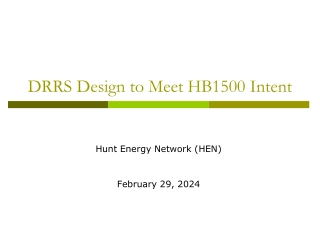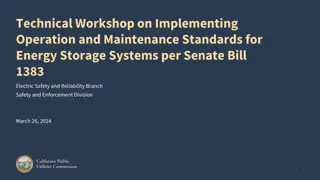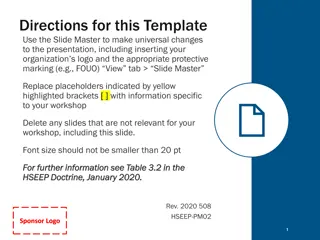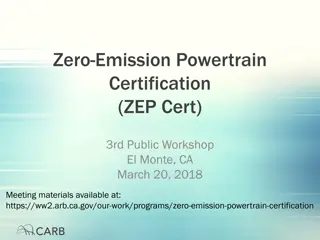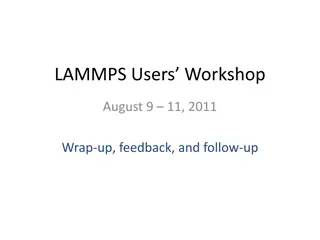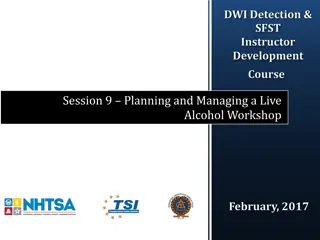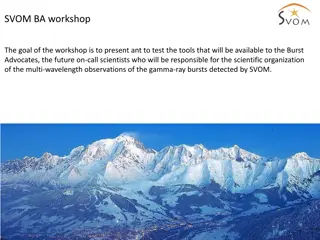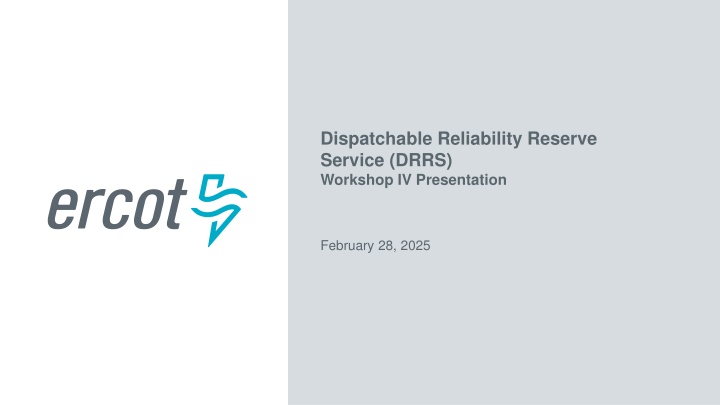
Deployment Considerations for Dispatchable Reliability Reserve Service Workshop Presentation
Dive into the intricacies of designing and deploying the Dispatchable Reliability Reserve Service (DRRS), focusing on stakeholder feedback, statutory requirements, real-time procurement, and future considerations. Explore the evolution of DRRS design concepts and the need to balance operational uncertainty with resource adequacy in the ERCOT framework.
Download Presentation

Please find below an Image/Link to download the presentation.
The content on the website is provided AS IS for your information and personal use only. It may not be sold, licensed, or shared on other websites without obtaining consent from the author. If you encounter any issues during the download, it is possible that the publisher has removed the file from their server.
You are allowed to download the files provided on this website for personal or commercial use, subject to the condition that they are used lawfully. All files are the property of their respective owners.
The content on the website is provided AS IS for your information and personal use only. It may not be sold, licensed, or shared on other websites without obtaining consent from the author.
E N D
Presentation Transcript
Dispatchable Reliability Reserve Service (DRRS) Workshop IV Presentation February 28, 2025
Agenda DRRS Design Recap Purpose Statutory Requirements Deployment in RUC Real-Time Procurement Other issues and considerations Discussion Next Steps 2 PUBLIC
DRRS Design Recap Through 2024 and the beginning of 2025, ERCOT and stakeholders have been developing the concept of DRRS as an Ancillary Service. NPRR1235 had been the primary vehicle for specifying how the attributes specified in PURA 39.159(d) and other design elements will be incorporated in the Protocols. Continued discussion on whether DRRS should be designed to meet operational uncertainty needs as well as be designed to incentivize additional resource adequacy. At the December 19, 2024 Open Meeting, the PUCT encouraged ERCOT to pursue a design for DRRS that addresses operational forecast uncertainty while preserving optionality in the design to allow for future market development for resource adequacy. At SAWG meetings throughout the fall, ERCOT and other stakeholders expressed concern about the impact on effective price formation that would be seen if NPRR1235 was given a further resource adequacy mandate through increased procurement quantities. In November, ERCOT presented and asked for stakeholder feedback on two high-level design concepts for DRRS that could achieve its operational mandate with future flexibility Additional conceptual designs from IMM and Hunt Energy Network reviewed at January 2025 SAWG 3 PUBLIC
DRRS Design Recap Stakeholder Feedback Overall, stakeholders will need more detail on each of the design concepts to provide further feedback and ultimately express a preference A common theme to the feedback was the importance of ensuring appropriate real-time outcomes while addressing the statutory language. This will be a focus today. 4 PUBLIC
Purpose Focus of this workshop is on procurement and deployment of DRRS with a focus on real-time issues and considerations This presentation will not be an in-depth review of individual design options and consideration Detailed design options and discussions will be the focus of a future workshop Next slides will use DRRS statute as the basis to identify constraints that need to be accounted for in any DRRS design What are statutory requirements? What constraints does this create in the design of DRRS? What options are available within these constraints and how do they apply to different timeframes and Resource types (e.g., On-Line and Off-Line)? 5 PUBLIC
DRRS Statutory Requirements The impetus for developing DRRS comes from Public Utility Regulatory Act (PURA) 39.159(d)-(e): (d) The commission shall require the independent organization certified under Section 39.151 for the ERCOT power region to develop and implement an ancillary services program to procure dispatchable reliability reserve services on a day-ahead and real-time basis to account for market uncertainty. Under the required program, the independent organization shall: 1) determine the quantity of services necessary based on historical variations in generation availability for each season based on a targeted reliability standard or goal, including intermittency of non-dispatchable generation facilities and forced outage rates, for dispatchable generation facilities; 2) develop criteria for resource participation that require a resource to: A. be capable of running for at least four hours at the resource's high sustained limit; B. be online and dispatchable not more than two hours after being called on for deployment; and C. have the dispatchable flexibility to address inter-hour operational challenges; and 3) reduce the amount of reliability unit commitment by the amount of dispatchable reliability reserve services procured under this section. 6 PUBLIC
RUC Overview Reliability Unit Commitment (RUC) Purpose: Ensure that enough Resource capacity is committed to reliably serve the forecasted Load on the ERCOT System and meet Ancillary Service capability needs over a multi-hour time horizon Timeline: For a given Operating Hour, RUC processes start from Day-Ahead RUC (DRUC) and each Hourly RUC (HRUC) runs ~60 minutes before the Operating Hour 7 PUBLIC
PURA 39.159(d)(3) Constraint: To satisfy this statutory requirement decisions to deploy Off-Line DRRS must be made no later than when the commitment determinations of other OFF Resources are evaluated by RUC Must respect the ramp eligibility/limitations of Off-Line DRRS Resources, i.e., PURA 39.159(d)(2)(B) requirement: online not more than two hours after being called on for deployment * Any reduction in ramp eligibility would impact pool of DRRS capacity RUC is the reliability backstop; Operators cannot forgo making a commitment of additional capacity if it is determined to be required Does not apply to On-Line DRRS because HSL of any On-Line Resource already accounted for in RUC Note that the RUC optimization would not be designed to procure DRRS (DRRS demand curve not included in RUC optimization and RUC will not commit Resources to meet DRRS plans for future hours) *Corresponding to 2-hour ramp requirement i.e., the last HRUC to deploy DRRS for HE 13 would be the HRUC that completes ~a few minutes after HE 10 8 PUBLIC
DRRS Statute (d) The commission shall require the independent organization certified under Section 39.151 for the ERCOT power region to develop and implement an ancillary services program to procure dispatchable reliability reserve services on a day-ahead and real-time basis to account for market uncertainty. Under the required program, the independent organization shall: 1) determine the quantity of services necessary based on historical variations in generation availability for each season based on a targeted reliability standard or goal, including intermittency of non-dispatchable generation facilities and forced outage rates, for dispatchable generation facilities; 2) develop criteria for resource participation that require a resource to: A. be capable of running for at least four hours at the resource's high sustained limit; B. be online and dispatchable not more than two hours after being called on for deployment; and C. have the dispatchable flexibility to address inter-hour operational challenges; and 3) reduce the amount of reliability unit commitment by the amount of dispatchable reliability reserve services procured under this section. 9 PUBLIC
Real-Time Procurement Discussion COP Resource Status: DRRS = Off-Line Resources with a DRRS in the DAM ON = Includes On-Line Resources with a DRRS award in the DAM Proposed designs enable On-Line Resources to receive DRRS awards Including eligible dispatchable Generation Resources and Energy Storage Resources (maximum injection capability) DRRS awarded to On-Line Resources in the DAM may incent some Generation Resources that are on the margin to self-commit Any Resource that self-commits as a result of a DRRS award in the DAM will reflect this in their COP status ( ON ) which will help mitigate the need for RUC instructions for that hour HSL of Off-Line DRRS Resources deployed via the RUC engine would be accounted for in the pricing run of the RDPA 10 PUBLIC
Real-Time Procurement Discussion COP Resource Status: DRRS = Off-Line Resources with a DRRS in the DAM ON = Includes On-Line Resources with a DRRS award in the DAM DRRS ASDC for Real-Time SCED same as DAM Co-optimization will need to account for State of Charge (SOC) constraints Real-Time DRRS awards can be given to: Off-Line DRRS* On-Line DRRS-Eligible Generation and Energy Storage Resources (maximum injection capability) *Resources that are Off-Line in Real-Timewith a telemetered status of DRRS which also had previously submitted and maintained a COP status of either DRRS or ON for DRUC and each run of HRUC for a given Operating Hour Includes any Off-Line DRRS Resource that was deployed via RUC, which would then be ON in Real-Time 11 PUBLIC
Real-Time Procurement Discussion DRUC/HRUC COP for validation for Off-Line DRRS Resources is required to: Ensure Off-Line Resources which received a DRRS award in DAM reflected and maintained this in their COP (i.e., it was always available to RUC if needed) Inclusion of ON in this validation is necessary for a case where a Resource changed their status to ON (i.e., intending to self-commit for a future hour) but subsequently changed their status back to DRRS for that hour (accounted for in the next HRUC) Without this validation check, a Resource with an Off-Line DRRS award could strategically avoid a deployment in RUC via their COP Resource Status 12 PUBLIC
Example 1: Off-Line DRRS Not Deployed via RUC HRUC HE Resource COP Status DRRS DRRS DRRS DRRS DRRS DRRS DRRS DRRS DRRS DRRS DRRS DRRS RUC Status Notes Resource awarded DRRS in the DAM 17 17 17 17 17 17 17 17 17 17 17 17 OFF OFF OFF OFF OFF OFF OFF OFF OFF OFF OFF OFF 05:15 06:15 07:15 08:15 09:15 10:15 11:15 12:15 13:15 14:15 15:15 16:16 Capacity available for RUC No deployment Real-Time Telemetered Status: DRRS Available for Real-Time DRRS award 13 PUBLIC
Example 2: Off-Line DRRS and Deployed via RUC HRUC HE Resource COP Status DRRS DRRS DRRS DRRS RUC Status Notes Resource awarded DRRS in the DAM 17 17 17 17 OFF OFF OFF ON 05:15 06:15 07:15 08:15 Capacity available for RUC Resource Committed by RUC Deployed via RUC 17 17 17 17 17 17 17 17 ON ON ON ON ON ON ON ON ON ON ON ON ON ON ON ON 09:15 10:15 11:15 12:15 13:15 14:15 15:15 16:16 Real-Time Telemetered Status: ON Available for Real-Time DRRS award 14 PUBLIC
Example 3: Off-Line DRRS from Day-Ahead to Real-Time HRUC HE Resource COP Status DRRS DRRS ON RUC Status Notes Resource awarded DRRS in the DAM 17 17 17 OFF OFF ON 05:15 06:15 07:15 Capacity available/accounted for by RUC Resource changes status to ON indicating plan to self- commit for that HOUR No deployment Real-Time Telemetered Status: DRRS 17 17 08:15 09:15 ON DRRS ON OFF No longer plans to self-commit and reflects change in status to DRRS Available for Real-Time DRRS award 17 17 17 17 17 17 17 DRRS DRRS DRRS DRRS DRRS DRRS DRRS OFF OFF OFF OFF OFF OFF OFF 10:15 11:15 12:15 13:15 14:15 15:15 16:16 15 PUBLIC
Example 4: Off-Line DRRS that Self-Commits HRUC HE Resource COP Status DRRS DRRS ON RUC Status Notes Resource awarded DRRS in the DAM 17 17 17 OFF OFF ON 05:15 06:15 07:15 Decides to self-commit for Hour Ending (HE) 17 Resource changes status to ON indicating plan to self- commit for that Hour Real-Time Telemetered Status: ON 17 17 17 17 17 17 17 17 17 ON ON ON ON ON ON ON ON ON ON ON ON ON ON ON ON ON ON 08:15 09:15 10:15 11:15 12:15 13:15 14:15 15:15 16:16 Available for Real-Time DRRS award 16 PUBLIC
Summary DRRS Procured in DAM using ASDC [PURA 39.159(d)] Both On-Line and Off-Line Resources which meet eligibility Requirements Off-Line DRRS Resources Deployed via RUC with a 1:1 RUC Offset [PURA 39.159(d)(3)] Resources with an On-Line DRRS award in the DAM may chose to self-commit and reflect this with a COP status of ON Real-Time Co-optimization of DRRS in SCED using ASDC (same as DAM) [PURA 39.159(d)] Off-Line DRRS: Resources that are Off-Line in Real-Time with a telemetered status of DRRS which had previously submitted and maintained a COP status of either DRRS or ON for DRUC and each run of HRUC for a given Operating Hour On-Line DRRS-Eligible Generation and Energy Storage Resources (maximum injection capability) 17 PUBLIC
Real-Time Procurement Discussion What additional Real-Time procurement issues need to be considered? 18 PUBLIC
Other Issues and Considerations 19 PUBLIC
Settlement Impacts between DAM and RT Awards DRRS awarded in the DAM will be paid the DAM MCPC for DRRS The QSE will be assessed a charge or payment based on their DRRS obligation minus self arranged MW amount in DAM The DRRS Obligation will be reallocated in Real-Time based on the QSE's Hourly Load Ratio Share AS imbalance concept under RTC for existing Ancillary Services can also be applied to DRRS Under RTC, there will be a separate AS imbalance calculation for each AS product. Non-zero net AS imbalance amounts will be charged or paid to QSEs on a Load Ratio Share (LRS) basis. If the DAM award plus self-arrangement plus net trade MW amounts are exactly balanced with the RTM award MW amounts, there will be no LRS-based charges or payment The basis for the approach to the RTC AS imbalance calculation is the current process for energy imbalance payments and charges. No Make-Whole payment if RUC instructs Off-Line DRRS resource to come On-Line Further discussion required on RUC Capacity Short Calculation commensurate with design What additional settlement-related questions need to be considered/flagged? 20 PUBLIC
DRRS Performance Monitoring Any design will need to consider performance particularly where Off-Line DRRS Resources which receive a deployment instruction appear to regularly fail to meet performance requirements Any initial feedback on performance monitoring parameters? 21 PUBLIC
DRRS Qualification Requirements What options exist and what issues need to be considered to determine and apply statutory qualification requirements? 22 PUBLIC
Next Steps Feedback on items discussed today Feedback on focus and presentations for next workshop 23 PUBLIC

